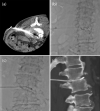Usefulness of Percutaneous Drainage in Determining the Causative Microorganism in Patients with Spondylodiscitis: A Retrospective Cross-Sectional Study
- PMID: 37457675
- PMCID: PMC10348065
- DOI: 10.5334/jbsr.3127
Usefulness of Percutaneous Drainage in Determining the Causative Microorganism in Patients with Spondylodiscitis: A Retrospective Cross-Sectional Study
Abstract
Purpose: To determine the usefulness of CT-guided percutaneous drainage for the causative microorganism detection in patients with spondylodiscitis.
Materials and methods: Data of patients who underwent CT-guided percutaneous drainage for spondylodiscitis from January 2014 to April 2022 were extracted from the radiological database of our hospital and investigated. The administration rate of antibiotics prior to blood culture and CT-guided percutaneous drainage (CTPD) were analyzed. The detection rate of microorganisms via blood culture and CT-guided percutaneous drainage were compared using the Mann-Whitney's U test with the SPSS software.
Results: In this study, a total of 30 (20 male and 10 female) patients were analyzed. A total of 13 patients (43%) were administered antibiotics prior to blood culture. Of them, microorganisms were detected via blood culture in only one patient (7%). A total of 25 patients (83%) were administered antibiotics prior to CTPD. Of them, the causative microorganisms in 19 patients (76%) were detected. Overall, the causative microorganism could be detected in 24 out of 26 patients (92%) via CT-guided percutaneous drainage. There was a statistical significance in the detection rate of microorganisms between blood culture and CTPD (P = 0.004) in favor of CTPD.
Conclusion: CT-guided percutaneous drainage showed a high positive rate of microorganism detection in patients with spondylodiscitis regardless of antibiotic administration prior to the procedure. CT-guided percutaneous drainage can be a solution for the detection of the causative microorganism in spondylodiscitis patients who received antibiotics before obtaining any culture.
Keywords: drainage; infection; spondylodiscitis.
Copyright: © 2023 The Author(s).
Conflict of interest statement
The authors have no competing interests to declare.
Figures


References
LinkOut - more resources
Full Text Sources
Miscellaneous

